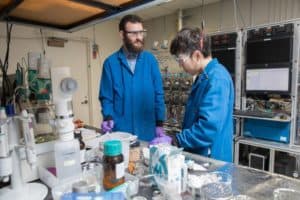
IBM researchers work in the IBM Research Battery Lab to combine and test unique materials and formulations for more sustainable battery technologies. [source]
Most commercial batteries have some metals inside of them. Common battery types like lithium-ion, lead-acid, or nickel-cadmium contain a range of heavy metals. While not all batteries are equally toxic, certain materials within them can pose concerns on health, safety, and the environment, especially if they are not disposed of properly and open and leak into the soil.
Metals inside batteries can be recovered, recycled, and reused to a certain extent depending on the material. However the recycling process can be complicated, arduous, and unprofitable. As the demand for energy storage continues to rise, there has been exploration into creating non-toxic and easily recyclable alternatives. From materials extraction to disposal, the ideal solution would be one that is sustainable and environmentally friendly from start to finish.
What’s so toxic about batteries?
Batteries are generally harmless while sealed. They can be touched and handled safely if the structure of the batteries hasn’t been compromised. However, when exposed to the body or to the environment, the metals found inside the batteries can be harmful.
Lithium-ion batteries are relatively safe on their own. Two heavy metals, nickel and cobalt, are commonly used in them as part of the cathode. In small amounts they are harmless. However, with the sheer number of batteries reaching end-of-life and being thrown away, the accumulation of metals can become toxic and dangerous to people and the environment. Moreover, because they are flammable, they can also be a fire hazard.
In Europe, li-ion batteries cannot be thrown into landfills because of toxicity and the danger of explosion.
In the US, multiple recycling plants have caught fire because of these batteries. When the batteries are underneath the weight of other waste, the cells can become damaged, triggering a thermal runaway event, eventually catching fire. Waste fires in landfills can also be extremely hard to put out and can burn for years.
Lead-acid batteries have been in use in cars since the 1910s. While the process of recycling lead-acid batteries is quite matured, lead is harmful when leaked into the environment. If breathed or ingested, it can cause developmental problems especially in babies and children. Cadmium is even more toxic than lead when ingested. Prolonged exposure to the metal can cause respiratory and kidney damage.
Aren’t batteries being recycled now?
While 90% of all lead-acid batteries are being recycled, only 50% of lithium-ion are. This means that a lot of reusable materials are going to waste. Though there is incentive to retrieve high-demand and costly materials such as cobalt or lithium, the process of recycling lithium-ion batteries is not profitable. Currently, the cost of recycling is greater than the price of the retrieved materials. Besides lithium, nickel, and cobalt, the battery may also contain manganese, graphite, copper, and aluminium. Separating these materials is a long process and not all retrieved materials can be reused for batteries. Many different companies are working to refine this process especially as more and more consumer products reach end-of-life.
However, recycling batteries does not necessarily address the inherent toxicity of the materials being used. In response to this, research has been done to develop non-toxic alternatives. Battery test equipment from Arbin plays a critical role in these efforts. Arbin’s MSTAT and LBT cell-cyclers have the precision necessary to accelerate battery materials development.
Can batteries be non-toxic?
A team of researchers at Imperial College London created a battery prototype that makes use of thin films of plastic and salt water. The prototype can charge and discharge in a matter of seconds. It’s use of low-cost, non-toxic, non-flammable water-based electrolytes makes it a safe and easily recyclable battery.
Although the prototype currently has low energy density, because of its ability to quickly charge and discharge, they could be beneficial for applications that need a high power density but not necessarily high energy capacities. One example of this would be renewable energy grid storage. Batteries would be able to charge quickly and release energy to the electric grid when necessary.
Other research is looking into developing nickel and cobalt free batteries. This design would replace the two metals in the cathode as well as use a safe liquid electrolyte with a high flash point, reducing the concerns of flammability with batteries.
Conclusion
With the added concerns surrounding the mining of some of these metals, it is understandable why there is a push to find better energy alternatives. As the world moves towards a more sustainable and environmentally conscious society, it is crucial to use materials that fully support this mission and create a safer solution for energy storage.


